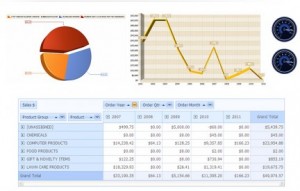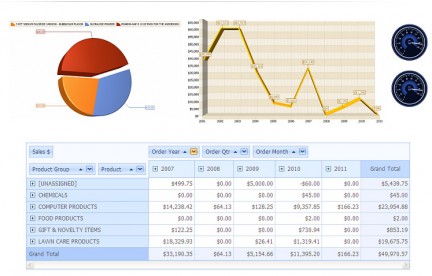by Gireesh A
Emerging to RFID Enterprise Solution
About RFID
Radio frequency identification or RFID, is a generic term for technologies that use radio waves to automatically identify people or objects. There are several methods of identification, but the most common is to store a serial number that identifies a person or object, and perhaps other information, on a microchip that is attached to an antenna (the chip and the antenna together are called an RFID transponder or an RFID tag. Visit http://www.bigsquid.org for more information on this). The antenna enables the chip to transmit the identification information to a reader. The reader converts the radio waves reflected back from the RFID tag into digital information that can then be passed on to the computers that can make use of it.
Objective
The objective of any RFID system is to carry data in suitable transponders, generally known as tags, and to retrieve data, by machine-readable means, at a suitable time and place to satisfy particular application needs. Data within a tag may provide identification for an item in manufacture, goods in transit, a location, and identity of a vehicle, an animal or individual. By including additional data the prospect is provided for supporting applications through item specific information or instructions immediately available on reading the tag.
The system requires, in addition to tags, a means of reading or interrogating the tags and some means of communicating the data to a host computer or information management system. A system will also include a facility for entering or programming data into the tags. Quite often an antenna is distinguished as if it were a separate part of an RFID system. While its importance justifies the attention it must be seen as a feature that is present in both readers and tags, essential for the communication between the two. To understand and appreciate the capabilities of RFID systems it is necessary to consider their constituent parts. It is also necessary to consider the data flow requirements that influence the choice of systems and the practicalities of communicating across the air interface. By considering the system components and their function within the data flow chain it is possible to grasp most of the important issues that influence the effective application of RFID. However, it is useful to begin by briefly considering the manner in which wireless communication is achieved, as the techniques involved have an important bearing upon the design of the system components.
Components of RFID
RFID Reader :
The Reader is a radio frequency device used to read data from the microchip contained in the RFID tag. RFID readers use a variety of methods to communicate with tags. The most common method for reading passive tags at close range is called inductive coupling. Simply put, the coiled antenna of the reader creates a magnetic field with the coiled antenna of the tag. The tag draws energy from this field and uses it to send back waves to the reader, which is turned into digital information – the tag’s electronic product code.
A Reader comprises of a transmitter, receiver, control module and communication functions, sometimes called a transceiver in radio terms for it to link to a controlling PC. Readers should have an attached antenna, which is used to transmit and receive the radio frequency signal. Each reader is accompanied with PC compatible software that allows the user to read and program tags. Win 2K, XP, ME are some of the operating systems compatible with our Readers.
RFID Tag :
An RFID tag or transponder is a wireless system composed of an electronic chip (semi-conductor device) with a memory where data can be stored. The memory can be permanent or volatile. They are classified within two frequency ranges, namely 125 KHz (low frequency) and 13.56 MHz (high frequency).
The RFID Business Case:
RFID in the Receiving Business Process: RFID readers are placed in the receiving area to monitor pallet and case RFID tags. The RFID readers verify the pallet license plate, count the units on the pallet, identify the vendor, and confirm the purchase order receipt without human intervention in the business transaction.
RFID in the Conversion Business Process: RFID readers can be placed along the flow path of a manufacturing process. Work-in-process, or WIP, can be enabled by RFID tags for tracking and monitoring the conversion of raw materials and intermediates into finished goods and stock-keeping units. This material information is integrated with the ERP production order transaction process to track manufacturing steps and issue production transactions.
RFID in the Customer Order Picking Business Process: Forklift drivers will use RFID readers to select case and pallet materials to pick order and assemble the shipment. Elimination of staging and verification processes can yield savings. This material information is integrated with the ERP warehouse and order management process to update the customer order pick list.
RFID in the Shipping Business Process: Forklift drivers and warehouse bays will use RFID readers to track case and pallet materials onto trucks. This material information is integrated with the ERP warehouse and order management process to update the customer order shipment.
The RFID value proposition propagates if the RFID infrastructure is leveraged by other enterprises in the downstream value chain.
OUR PRODUCT : BIGSquid
BIGSquid RFID is all you need to get started with RFID. BIGSquid RFID is an ideal tool for any startup labs and research teams. BIGSquid RFID comes with one RFID READER, BIGSquid RFID middleware developer license and TAGS to get you started in speed to create your own RFID solution. (More info http://www.bigsquid.org )
BIGSquid RFID Tag
BIGSquid RFID Tag is an Industrial and Logistics RFID Transponder. BIGSquid RFID Tag’s unique design gives it, infinite life and makes it nearly indestructible as opposed to conventional Tags. (More info http://www.bigsquid.org )
BIGSquid RFID Reader
BIGSquid is an industrial grade RFID Reader and an intelligent device. BIGSquid Navigator has built-in features, which allows easy integration in large layouts as opposed to normal readers. Navigator is remotely programmable and controllable and can transmit the RFID TAG information to long distances directly without using any additional interfaces or hardware. (More info http://www.bigsquid.org )
BIGSquid Reader Controller Modules
BIGSquid Reader controller modules are an essential companion when you deploy multiple RFID readers in geographically separated locations. The reader controller modules allow you to control readers remotely using multiple digital I/O from other processes or machines. (More info http://www.bigsquid.org )
RS232 to Ethernet converter
The rs232 to Ethernet converter is a first-generation Serial Device Server that externally connects any existing serial device to an Ethernet (TCP/IP) network. The rs232 to Ethernet converter features a compact and stylish design. (More info http://www.bigsquid.org )
BIGSquid RFID Middleware Server
The Server part of the BIGSquid RFID collects the tag information and updates in the database. The server will be running in the backend as a Service. Whenever there is a read at any particular reader it will be validated and will be stored in database against particular inventory.
The server will read the tag value precisely and will not miss any valid data. The validation part first checks whether the data that has been captured is valid or not and then it will check for the object or inventory that tag value represents and stores the tag value against that inventory or object.
Please visit http://www.bigsquid.org to get more information on related topics. Contact us http://www.bigsquid.org/Contactus.html
Satheesh G Nair. CEO BIGSquid



